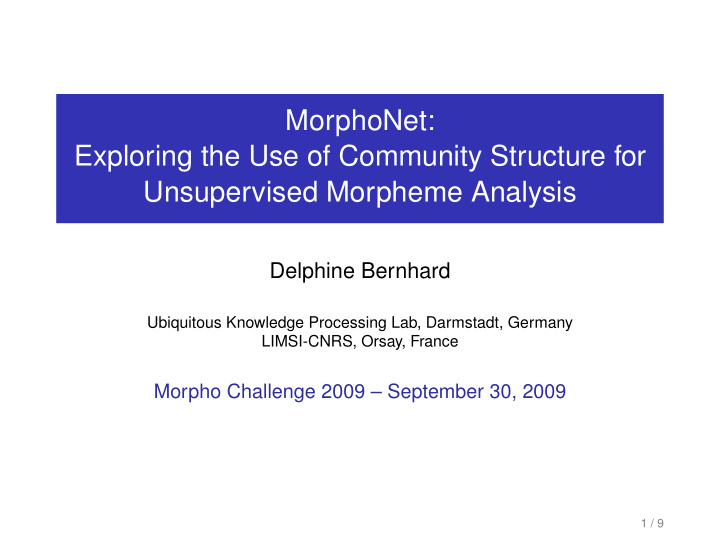



MorphoNet: Exploring the Use of Community Structure for Unsupervised Morpheme Analysis Delphine Bernhard Ubiquitous Knowledge Processing Lab, Darmstadt, Germany LIMSI-CNRS, Orsay, France Morpho Challenge 2009 – September 30, 2009 1 / 9
Main features of the method ◮ Algorithm relying on a network representation of morphological relations between words ◮ Goal: investigate the use of community structure for morphology induction ◮ Networks with community structure contain groups of nodes with dense interconnections ◮ In our case, communities correspond to families of morphologically related words ◮ Related to work on networks in other areas of NLP , e.g. word clustering [Matsuo et al., 2006], word sense disambiguation [Mihalcea, 2005] or keyword extraction [Mihalcea and Tarau, 2004] 2 / 9
Overview of the method 1. Acquisition of morphological transformation rules 2. Construction of a lexical network 3. Identification of word families using community structure 4. Acquisition of morpheme analyses 3 / 9
Step 1: Acquisition of morphological transformation rules ◮ Morphological transformation rules make it possible to transform one word into another by performing substring substitutions ˆ(.+)ly$ → \1 totally → total ◮ These rules are acquired using a subset L of the wordlist W provided for each language (we used 10,000 words) ◮ Graphically similar words in L are first identified using a gestalt approach to fuzzy pattern matching based on the Ratcliff-Obershelp algorithm ◮ Rules are then obtained by comparing these graphically similar words democratic – undemocratic : ˆun(.+)$ → \1 4 / 9
Step 2: Construction of a lexical network insulation's insultingly ◮ Rules are used to build a lexical network insulating insulators insulting represented as a graph ◮ Nodes in the graph insulation insulted represent words from insulated insults the input word list W ◮ Two words w 1 and w 2 insulates insult are connected by an edge if there exists a insulator transformation rule R insulate such that R( w 1 ) = w 2 . 5 / 9
Step 3: Identification of word families ◮ Communities are detected in the lexical network, using a clustering algorithm ◮ Communities correspond to groups of tightly-knit nodes characterised by a high intra-group edge density and a lower inter-group density ◮ Use of the clustering algorithm proposed by Newman [Newman, 2004] to identify communities which correspond to word families 6 / 9
Step 4: Acquisition of morpheme analyses ◮ Identification of a representative word for each word family (shortest word) ◮ The full morpheme analysis for a word form w consists of its family representative and a string representation of the transformation rules that apply to w Example ◮ Word family { insulted ; insulting ; insult ; insults ; insultingly } ◮ Family representative: insult ◮ Complete analyses: insultingly insult _ly _ingly insulting insult _ing insulted insult _ed insults insult _s insult insult 7 / 9
Conclusions and future work ◮ Promising results obtained at Morpho Challenge 2009 ◮ Future improvements: ◮ Increase recall by providing a better method for the acquisition of transformation rules ◮ Weight edges in the network ◮ Devise a more elaborate method for obtaining complete morpheme analyses ◮ Address compounding 8 / 9
Thank you! Questions? Delphine.Bernhard@googlemail.com
References Matsuo, Y., Sakaki, T., Uchiyama, K., and Ishizuka, M. (2006). Graph-based Word Clustering using a Web Search Engine. In Proceedings of the 2006 Conference on Empirical Methods in Natural Language Processing, pages 542–550. Mihalcea, R. (2005). Unsupervised Large-Vocabulary Word Sense Disambiguation with Graph-based Algorithms for Sequence Data Labeling. In Proceedings of the HLT/EMNLP 2005 Conference, pages 411–418. Mihalcea, R. and Tarau, P . (2004). TextRank: Bringing Order into Texts. In Lin, D. and Wu, D., editors, Proceedings of EMNLP 2004, pages 404–411. Newman, M. E. J. (2004). Fast algorithm for detecting community structure in networks. Physical Review E, 69.
Recommend
More recommend